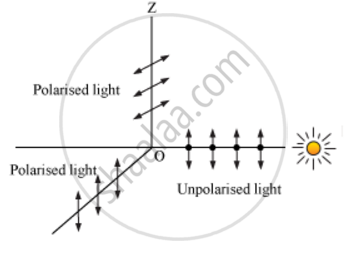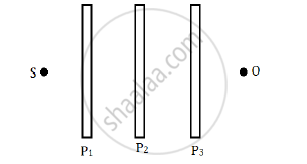Advertisements
Advertisements
प्रश्न
Show, with the help of a diagram, how unpolarised sunlight gets polarised due to scattering.
उत्तर
Unpolarized light scattering from air molecules shakes their electrons perpendicular to the direction of the original ray. The scattered light therefore has a polarisation perpendicular to the original direction and none parallel to the original direction.

APPEARS IN
संबंधित प्रश्न
Draw a neat labelled diagram showing the plane of vibration and plane of polarisation for polarised light.
Three identical polaroid sheets P1, P2 and P3 are oriented so that the pass axis of P2 and P3 are inclined at angles of 60° and 90° respectively with the pass axis of P1. A monochromatic source S of unpolarised light of intensity I0 is kept in front of the polaroid sheet P1 as shown in the figure. Determine the intensities of light as observed by the observer at O, when polaroid P3 is rotated with respect to P2 at angles θ = 30° and 60°.

Using the phenomenon of polarisation, show how the transverse nature of light can be demonstrated.
Two polaroids P1 and P2 are placed with their pass axes perpendicular to each other. Unpolarised light of intensity I0 is incident on P1. A third polaroid P3 is kept in between P1 and P2 such that its pass axis makes an angle of 60° with that of P1. Determine the intensity of light transmitted through P1, P2 and P3.
What is the Brewster angle for air to glass transition? (Refractive index of glass = 1.5)
What does a polaroid consist of? How does it produce a linearly polarised light?
What is polarisation?
State and obtain Malus’ law.
What is normal focusing?
Can reflection result in plane polarised light if the light is incident on the interface from the side with higher refractive index?
